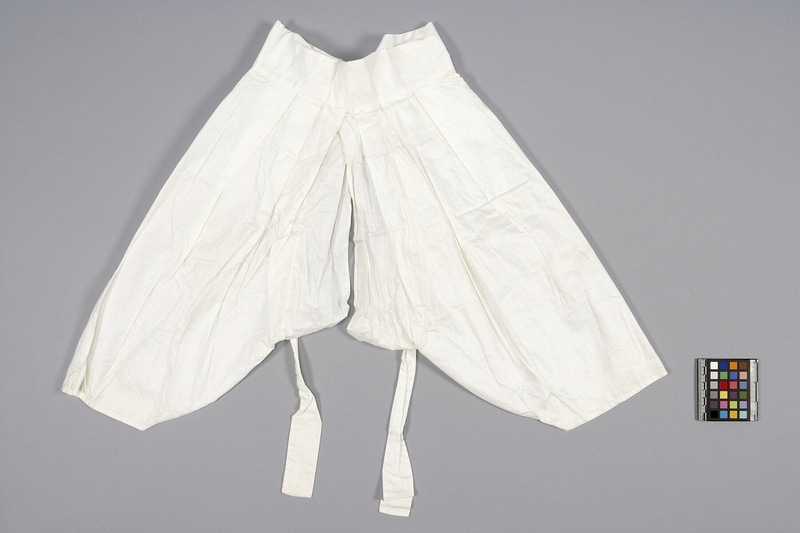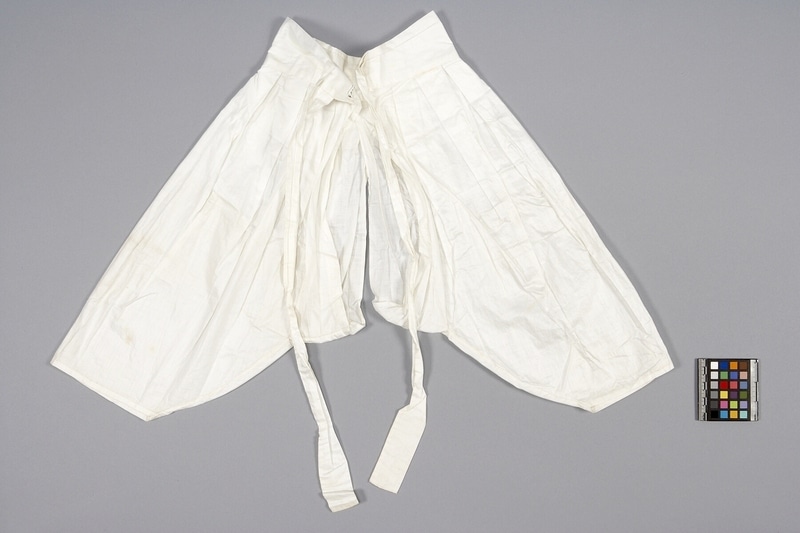Underwear Item Number: N3.8 from the MOA: University of British Columbia


Description
Under-trousers of very fine white cotton fabric with a sheen. Pants are angled out from the waistband to the ankles. Body of pants is pleated onto a wide waistband opening at the back. At each side of the waistband opening is attached a narrower long tie. Pleats face towards the centre, front and back. Crotch is low, ending above the knees, and open. On each side of the crotch opening is sewn an additional panel, extending from the lower edge of the front of the waistband to each side of the back opening. Panels overlap where they are attached to the front of the waistband so that one inserts into the other. The inner seams of the legs below the panels form convex curves, so that the pants are narrower at the ankles.
History Of Use
Such under-trousers would have been worn by a girl three to five years of age as her second layer of under-wear, in any season except winter. She would have worn a pair with straight legs underneath, and another over the top. Such underwear had a crotch slit that continued to the front, but this was later simplified during the modernization of Korea and the slit limited to the back. Later, shoulder straps were added. More elaborated underwear like this pair had additional flaps at the crotch to ensure that the skin was covered, which was very important during the Chosun Dynasty. Ordinary people wore more simple underwear, the construction of which was not elaborated. Only women’s and girl’s under-trousers had the slit; men’s did not. Men also did not wear as many layers of underwear as women did. Such underwear, entirely hand sewn, was probably made at home for a child in the family. Underwear was and is boiled as part of the laundry process. Women wore the following layers of lower-body underwear: loincloth that passed between the legs and fastened front and back to a waistband (Da-ri-sok-got); , wide, straight-legged under-trousers with a side opening with ties as well as a crotch slit with flaps (Sok-sok-got); back- or side-opening under-trousers tapering to the ankles, with flaps at the opening (Sok-ba-ji); wide , straight-legged under-trousers with crotch slit and flaps (Dan-sok-got); under-skirt (Sok-chima); and outer skirt (Chima). Many layers of underwear were important to add bulk for elegance, and to protect their virginity. Underwear was tied below the wearer’s breasts, and extended to the back of her foot. Entertainers might intentionally show their ankles and the edge of their underwear.
Specific Techniques
Sewn entirely by hand. The edges of the fabric are enclosed in the very narrow and precise seams called “Ssam-sol”. To create these seams, the layers were sewn together and then one side was trimmed so that the edge of the other could be folded over it, and then sewn again. After sewing, the seams were pasted flat. The ties were sewn inside-out and then turned right-side out, concealing the seam. The hems and edges of panels were finely hand-sewn with invisible stitches. The fabric was made shiny by boiling it with a chemical.
Item History
- Made in Korea before 1939
- Collected between 1899 and 1939
- Owned by Marion Stephan before August 1964
- Received from Marion Stephan (Donor) during August 1964
What
- Name
- Underwear
- Identification Number
- N3.8
- Type of Item
- underwear
- Material
- cotton fibre and paste adhesive
- Manufacturing Technique
- spun, woven, cut, sewn, turned and pasted
- Overall
- height 56.0 cm, width 79.5 cm
Who
- Culture
- Korean
- Previous Owner
- Marion Stephan
- Received from
- Marion Stephan (Donor)
Where
- Holding Institution
- MOA: University of British Columbia
- Made in
- Korea
When
- Creation Date
- before 1939
- Collection Date
- between 1899 and 1939
- Ownership Date
- before August 1964
- Acquisition Date
- during August 1964
Other
- Item Classes
- textiles
- Condition
- good
- Accession Number
- 0113/0078